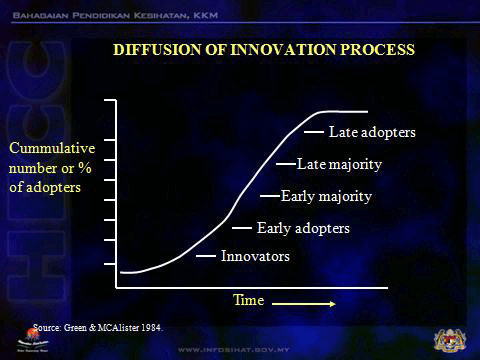
It is a process by which an innovation is communicated through certain channels over a period among the members of a social system or a given culture. Innovation is an idea, practice, or object that is perceived to be new by an individual or another unit of adoption. Diffusion of innovation theory predicts that media, as well as interpersonal contacts, provide information and influence opinion and judgment. You need to apply this theory in planning and conducting model family training at the community level. (You will discuss the model family training in Session 12 of this module)
When it comes to the process of innovation-decisions, Rogers (1995) mentioned that there are five stages.
The speed with which each passes through these 5 stages will vary depending on the particular innovation, its overall complexity, its costs, and just how disruptive it is to current workflows, or measured by the length of time required for a certain percentage of the members of that social system to adopt an innovation.In general, individuals who first adopt an innovation require a shorter adoption period than late adopters.
There becomes a point at which an innovation reaches a "critical mass". This is a point in time within the adoption process that sufficient individuals have adopted an innovation so that the continued adoption of the innovation becomes self-sustaining. There are some strategies that help an innovation to become accepted. These include having an innovation adopted by respected individuals in your community. It is always helpful to introduce an innovation into a group of individuals who are ready to accept an innovation and who will provide positive reactions and benefits for early adopters of the innovation.
The adoption of ideas in a community diffuses among individuals in that community at varying rates. Early in the introduction of a new idea, it is picked up by ‘innovators’ (between 2 and 3% of the target population) who are venturesome, independent, risky and daring. They want to be the first to do things, and they may not be respected by others in the social system. The second group of people, the ‘early adopters’ (about 14% of the target population) are very interested in the innovation, but they are not the first to sign up. They wait until the innovators are already involved to make sure the innovation is useful. They are respected by others in the social system and looked at as opinion leaders, like religious leaders, community leaders.., etc

The next group ‘early majority’ (about 34% of the target population) may be interested in the innovation but will need external motivation to become involved; They will deliberate for some time before making a decision. The ‘late majority’ (also about 34% of the target population) are next, and it will take more time to get them involved for they are sceptical and will not adopt an innovation until most people in the social system have done so.
The last group the 'laggards’ (about 16% of the target population) are not very interested in innovation and would be the last to become involved. They are very traditional and are suspicious of innovations. Laggards tend to have limited communication networks, so they do not know much about new things. This situation calls for different strategies for different categories of people and at different stages of the adoption process.